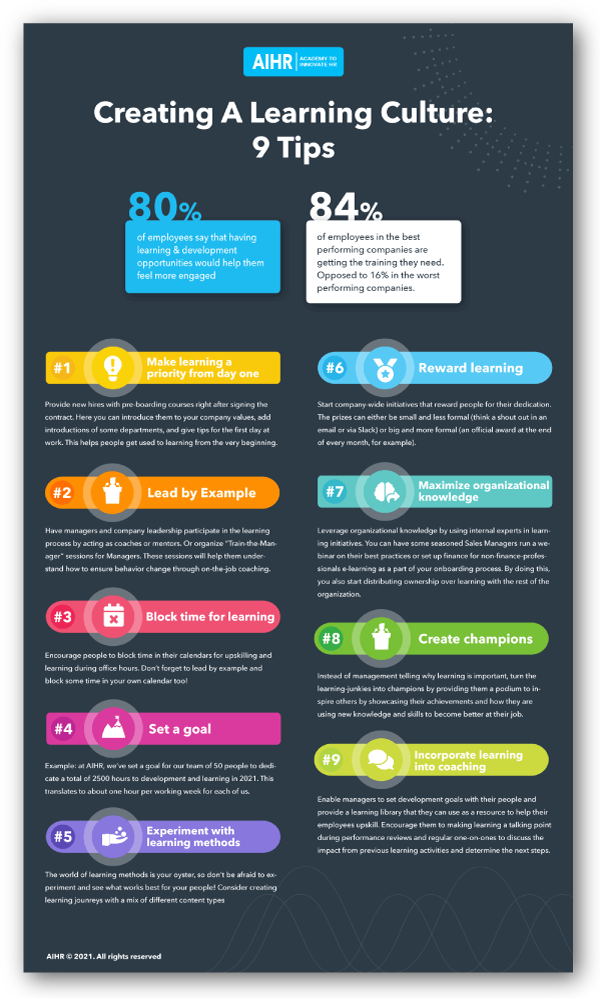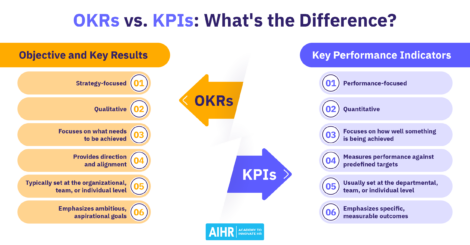9 Practical Tips to Start Creating a Learning Culture + Infographic

The growth of your organization goes hand in hand with the growth of your people. This is why a culture of learning is a must for every organization.
Yet, 42% of managers continue to report creating a learning culture as one of their top three challenges (LinkedIn Workplace Learning Report, 2020). As concerning as this number is, it’s not entirely surprising.
Building a learning culture is an ongoing and challenging process and there are no quick fixes. A (learning) culture is not formed with a one-time event or policy change, it’s something that develops over time and needs to become part of your team’s or organization’s DNA.
So in this article, we will discuss everything that you need to know in order to start building a culture of learning.
What is a learning culture?
To put it simply, a learning culture is one where learning is at the forefront of the organizational values and strategy.
It is an environment where people who spend time on their development are not looked down upon but applauded and used as role-models. One where leaders encourage employees to equip themselves with the skills and knowledge necessary to perform at their best and enable the growth of your organization.
So what’s in it for you, or more specifically, your organization? Here are a few advantages to consider:
Maintain the competitive edge of your organization.
To stay on top and win in the marketplace, you need to make sure that your greatest asset – your people – is prepared for the challenges ahead. Implementing a learning culture can help you do just that.
Think about this: 84% of employees in the best performing organizations are getting the training they need, as opposed to just 16% in the worst-performing organizations (according to IBM). Is this merely a coincidence? We don’t think so.
A learning culture helps improve employee engagement.
Employee engagement remains a challenge for many organizations up to this day. How could it not, when only 15% of employees worldwide are engaged with their jobs (Gallup State of the Global Workplace report)?
The obvious solution to this is building a learning culture in your organization. Having well-established training programs in an environment that encourages learning can go a long way in engaging with your people. In one study, 80% of employees say that having learning and development opportunities would help them feel more engaged at work.
Increase job satisfaction and decrease employee turnover.
Empirical research shows that a strong learning culture can result in employees feeling more satisfied with their jobs. This in turn leads to a lower rate of attrition.
The benefits of higher job satisfaction and lower turnover are endless. Increased productivity, decreased loss usually associated with turnover, and more innovation, are a few. This is particularly significant for competitive labor markets such as the IT industry.
9 tips to start building a learning culture
We have outlined nine practical tips that will help you to foster a culture of learning in your organization or team.
Click here to download the pdf infographic with the summarized version of the 9 tips outlined below.
1. Make learning a top priority from day one
This one might seem rather obvious, but it is worth mentioning. Building a true learning culture starts with ensuring that learning is ingrained in your employees from the moment that they start at your organization.
Tip: You can start by providing your new hires with structured and effective onboarding courses. This can help your people get used to structured learning from the very beginning.
2. Lead by example
Here’s the thing about business culture: It’s often top-down.
This means that people follow the examples set by management. So make sure to involve your leaders in your learning culture from the beginning and ensure that they are actively investing in their own development.
Tip: There are several ways management can go about doing this. They can directly participate in the learning process by acting as coaches or mentors, or lend their expertise to create content for courses. Another way is to become learning advocates who encourage other team members to learn.
Check out our Learning Bite to learn everything you need to know about building a successful learning culture!
3. Set aside time for learning
Did you know that 83% of online learning happens during office hours?
The problem is that between deadlines, projects, and meetings, it is a challenge for your employees to set aside some time for learning. In the long run, your employees can become discouraged.
Tip: Turn yourself into a champion for learning time! Make clear to your employees that they are encouraged to block time in their calendars for upskilling during office hours. Don’t forget to lead by example and block some time in your own calendar too!
4. Motivate by setting a goal
Goal setting helps trigger new behaviors and focuses attention on learning initiatives. Keep in mind: the goals should be SMART in order to be motivating (specific, measurable, aggressive, realistic, and time-bound)
Example: At AIHR, we’ve set a goal for our team of 50 people to dedicate a total of 2500 hours to development and learning in 2021. This translates to about one hour per working week for each of us.
5. Experiment with learning methods
There are a million different approaches to learning out there. You might be keen on more semi-structured formats such as one-on-one coaching or group problem-solving. But others might prefer more structured approaches such as training sessions or online training courses. You can also mix various content types, which can include videos, webinars, hackathons, or coaching.
Tip: The world of learning methods is your oyster, so don’t be afraid to experiment and see what works best for your people!
6. Reward learning
This is a good way to let your employees know that the time and effort they put into learning are recognized.
Tip: Start company-wide initiatives that reward people for their dedication. The prizes can either be small and less formal (think a shout out in an email or via Slack) or big and more formal (an official award at the end of every month, for example).
7. Give and receive feedback
Providing a continuous stream of feedback plays an important role in ensuring employee engagement with learning. Building trusted relationships is all about give and take, so make sure that your employees know they are free to provide feedback for you as well.
Tip: Give feedback after a training session or at the end of the course. Either way, remember to make clear to your employees their strengths, weaknesses, and points of improvement. It is also good to remind them how the training they are doing can help them to reach their goals.
8. Use active learners as champions
You don’t have to rely solely on top-down culture building. Most likely you already have some learning-junkies within your organization. You know, those people that are constantly adding new certificates to their LinkedIn and raving about their latest course.
Tip: Instead of management explaining why learning is important, turn the learning-junkies into champions by providing them a podium to inspire others by showcasing their achievements and how they are using new knowledge and skills to become better at their job.
9. Incorporate learning into coaching
While it is true that learning often happens in groups, this doesn’t mean that you cannot bring learning into your one-on-one with your employees. This is the perfect place to understand your employees’ career ambitions and develop personalized learning schemes that can help them achieve their goals.
Tip: Consider making learning a talking point during performance reviews and your regular one-on-ones to discuss the impact from previous learning activities and determine the next steps.
Additional recommendations
Aside from these nine tips, we have some additional recommendations for you to keep in mind during your process of creating a learning culture.
- Make training easily accessible: If the learning process takes a lot of effort, your employees can become discouraged. Make sure that everything – from setting up an account to participating in lessons – is as seamless as possible. It is worth putting in some effort to ensure that the interface of your LMS is user-friendly.
- Develop personalized learning plans: We’re long past the point where a one-size-fits-all approach would suffice. Learning initiatives should be designed to be as relevant to your employees as possible. This can help increase engagement and desire to grow within your organization. One way to do this is to develop a skeleton learning plan and modify it according to your employees’ needs, learning styles, and career goals.
- Make learning social: Learning is better done in teams, so why not make this a part of your culture? You can try using the forum feature in your LMS. Encourage your employees to post topics, ask questions, and interact with each other.
Three golden rules for creating a culture of learning
Now that we’ve established how you can go about creating a learning culture for your organization, the final thing to consider is what you need to keep in mind as you embark on this challenging but rewarding journey.
- The first thing is that this is not a one-person job. No one person, not even the CEO, can take up the job of creating a learning culture by themselves. A learning culture is embedded in the system of your organization. It reaches, touches, and includes every person on every level.
- The second rule is that learning is a means to an end. The goal of learning is always about helping people reach their maximum potential and improving business outcomes. This can only happen when learning is deeply embedded in your organization’s DNA. Reject the notion that a learning culture can be wrapped up into several sessions completed over the course of a few weeks.
- Finally, keep in mind that the creation of a learning culture is more of a vision than a standardized project. Building a learning culture requires buy-in and the active participation of many stakeholders. Get together to discuss the vision, values, and key enablers that need to be in place to start building the desired culture. Go beyond discussing the how and make sure that you can answer the why – why do we want a learning culture and why should our people care?
No one-size-fits-all
Embedding a learning culture at all levels is extremely beneficial for your organization. It enables you to tap into the potential of your workforce and ensures that you stay on top of the market.
Every organization is unique and there’s no one-size-fits-all. So take what we’ve discussed above and tailor it to the needs and characteristics of your organization.
And if you feel that there is something that we should add, or you would like to share your own experience with building a learning culture in your organization, let us know!
Weekly update
Stay up-to-date with the latest news, trends, and resources in HR
Learn more
Related articles
Are you ready for the future of HR?
Learn modern and relevant HR skills, online











